Achieving 100% Renewable and Self-Sufficient Electricity in Impoverished, Rural, Northern Climates: Case Studies from Upper Michigan, USA
Abstract
:1. Introduction
1.1. Motivation
1.2. Literature Review
1.2.1. 100% RE Transition and Concerns for Unlikely Places
1.2.2. Community-Based 100% RE Modeling
1.2.3. 100% RE Transitions and Energy Justice Concern
1.3. Main Contributions
1.4. Paper Structure
2. Method
2.1. Key Performance Indicators
2.2. Electricity Demand
2.3. Climate
2.4. Solar Photovoltaics
2.5. Wind Turbines
2.6. Battery Storage
2.7. Existing Hydropower
2.8. Grid Connection
2.9. Energy Efficiency
2.10. System Level Parameters
3. Results
3.1. Baseline Results
3.2. PV Tilt Angle
3.3. Sensitivity Analysis
4. Discussion
4.1. Feasibility and Economic Justification of 100% RE Transition
4.2. Policy Implications and Future Work
5. Conclusions
Funding
Institutional Review Board Statement
Informed Consent Statement
Data Availability Statement
Acknowledgments
Conflicts of Interest
Appendix A
Appendix A.1. Components
Appendix A.1.1. Photovoltaics
- SunPower E20-327 [60]
- ○
- Nominal Efficiency: 20.4%
- ○
- Nominal Operating Cell Temperature: 45 °C
- ○
- Temperature Coefficient: −0.35%/°C
- Electrical Bus
- ○
- AC
- Site Specific Input
- Cost
- Sizing
- ○
- HOMER Optimizer
- Advanced Settings
- ○
- Inverter not explicitly modeled
- ○
- Orientation
- ■
- Ground Reflectance: 20%
- ■
- No Tracking
- ■
- Panel Slope: 30°, 45° and 60°
- ■
- Panel Azimuth: 0°
- ○
- Temperature effects are considered, parameters given with module specifications
Appendix A.1.2. Wind Turbines
- Enercon E-82 E2 [82]
- ○
- Rated Capacity: 2 MW
- Site Specific Input
- Electrical Bus
- ○
- AC
- Costs
- Sizing
- ○
- HOMER Optimizer
- Advanced Properties
- ○
- Power Curve [82]
| Wind Speed (m/s) | Power Output (kW) |
|---|---|
| 1 | 0 |
| 2 | 3 |
| 3 | 25 |
| 4 | 82 |
| 5 | 174 |
| 6 | 321 |
| 7 | 532 |
| 8 | 815 |
| 9 | 1180 |
| 10 | 1580 |
| 11 | 1810 |
| 12 | 2080 |
| 13 | 2050 |
| 14 | 2050 |
| 15 | 2050 |
| 16 | 2050 |
| 17 | 2050 |
| 18 | 2050 |
| 19 | 2050 |
| 20 | 2050 |
| 21 | 2050 |
| 22 | 2050 |
| 23 | 2050 |
| 24 | 2050 |
| 25 | 2050 |
- ○
- Turbine Losses
- ■
- Availability Losses: 0%
- ■
- Wake Effect Losses: 0%
- ■
- Turbine Performance Losses: 2%
- ■
- Electrical Losses. 2%
- ■
- Environmental Losses: 0%
- ■
- Curtailment Losses. 0%
- ■
- Other Losses. 0%
- ○
- Maintenance Table
- ■
- No maintenance schedule considered
Appendix A.1.3. Battery
- Idealized battery model w/Tesla Powerpack [87]
- ○
- Nominal Voltage: 380 V
- ○
- Nominal Capacity: 232 kWh
- ○
- Nominal Capacity: 611 Ah
- ○
- Roundtrip Efficiency: 89.5%
- ○
- Maximum Charge Current: 152 A
- ○
- Maximum Discharge Current: 152 A
- Cost
- Lifetime
- Site Specific Input
- ○
- String Size: 1
- ○
- Initial State of Charge: 100%
- ○
- Minimum State of Charge: 0%
- ○
- No minimum storage life
- ○
- No maintenance schedule considered
- Sizing
- ○
- HOMER Optimizer
Appendix A.1.4. Converter
- Generic large, free converter (from HOMER catalog)
- Costs
- ○
- Capacity: 1 kW
- ○
- Capital: $0
- ○
- Replacement: $0
- ○
- O&M: 0 $/kW/year
- Inverter Input
- ○
- Lifetime: 15 years
- ○
- Efficiency: 100%
- Rectifier Input
- ○
- Relative Capacity: 100%
- ○
- Efficiency: 100%
- Capacity Optimization
- ○
- Search Space
- ■
- 0 kW
- ■
- 9,999,999 kW
Appendix A.1.5. Grid Connection
- Modeled using Scheduled Rates
- Parameters
- ○
- Sale Capacity: 0 kW
- ○
- Annual Purchase Capacity: 590, 1432, 3150 kW (See Table 4)
- ○
- No net metering considered
- ○
- No maximum net grid purchases considered
- ○
- Grid Extension Charges
- ■
- Grid Capital Cost: 0 $/km
- ■
- Distance: 0 km
- ○
- Distributed Generation Costs
- ■
- Interconnection Charge: $0
- ■
- Standby Charge: 3900 $/year (represents fixed annual fees) [95]
- Rate Definition
- Demand Rates [95]
- ○
- On Peak
- ■
- 7:00–23:00 on weekdays
- ■
- Price: 6.30 $/kW/mo
- ○
- Off Peak
- ■
- All other times of day/week
- ■
- Price: 3.07 $/kW/mo
- ○
- For both rate periods
- ■
- No system dispatch override considered
- Reliability
- ○
- No outages considered (100% grid reliability)
- Emissions
- ○
- Ignored for this study
Appendix A.2. Resources
Appendix A.2.1. Solar GHI

Appendix A.2.2. Wind Speed
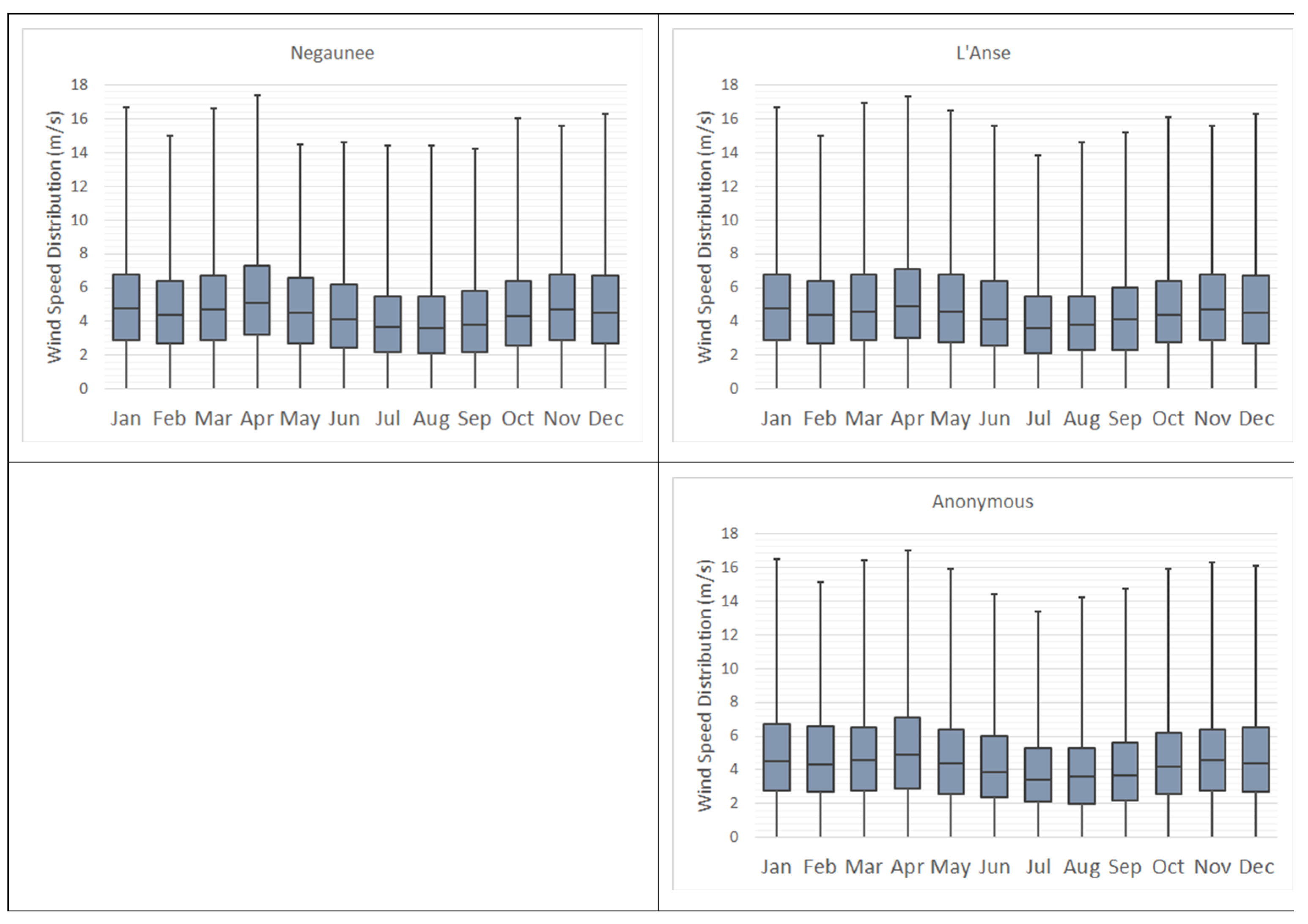
- Parameters [55]
- ○
- Altitude above sea level: 175–444 m
- ○
- Anemometer height: 10 m
- Variation with Height
- ○
- Wind speed profile: Logarithmic
- ○
- Surface roughness length: 0.010 m
- Advanced Parameters not applicable due to imported time series
Appendix A.2.3. Air Temperature

Appendix A.2.4. Project
Economics
- Expected Inflation Rate: 0% (Discount rates and prices are real)
- Project Lifetime: 30 years
- System fixed capital cost: $0
- System fixed O&M cost: $0/year
- Capacity shortage penalty: $0/kWh
Constraints
- Maximum annual capacity shortage: 0%
- Minimum renewable fraction: 75.6%, 82.1%, 85.4% (See Table 4)
- Operating Reserve
- ○
- As a percentage of load
- ■
- Load in current time step: 0%
- ■
- Annual peak load: 0%
- ○
- As a percentage of renewable output
- ■
- Solar power output: 0%
- ■
- Wind power output: 0%
Emissions
- No penalties or limits considered
Optimization
- Minutes per time step: 60
- Maximum simulations per optimization: 10,000
- System design precision: 0.0100
- NPC precision: 0.0100
- Focus factor: 50.00
- Category winners are optimized
Multi-Year
- No multi-year settings are enabled
References
- Rehfeldt, M.; Worrell, E.; Eichhammer, W.; Fleiter, T. A review of the emission reduction potential of fuel switch towards biomass and electricity in European basic materials industry until 2030. Renew. Sustain. Energy Rev. 2020, 120, 109672. [Google Scholar] [CrossRef]
- Masson-Delmotte, V.; Zhai, P.; Pörtner, H.-O.; Roberts, D.; Skea, J.; Shukla, P.R.; Pirani, A.; Moufouma-Okia, W.; Péan, C.; Pidcock, R.; et al. Global Warming of 1.5 °C. An IPCC Special Report on the Impacts of Global Warming of 1.5 °C Above Pre-Industrial Levels and Related Global Greenhouse Gas Emission Pathways, in the Context of Strengthening the Global Response to the Threat of Climate Change, Sustainable Development, and Efforts to Eradicate Poverty; IPCC: Geneva, Switzerland, 2019. [Google Scholar]
- Allen, M.; Antwi-Agyei, P.; Aragon-Durand, F.; Babiker, M.; Bertoldi, P.; Bind, M.; Brown, S.; Buckeridge, M.; Camilloni, I.; Cartwright, A.; et al. Technical Summary: Global Warming of 1.5 °C. An IPCC Special Report on the Impacts of Global Warming of 1.5 °C above Pre-Industrial Levels and Related Global Greenhouse Gas Emission Pathways, in the Context of Strengthening the Global Response to the Threat of Climate Change, Sustainable Development, and Efforts to Eradicate Poverty; IPCC: Geneva, Switzerland, 2018; pp. 31–94. Available online: https://www.ipcc.ch/site/assets/uploads/sites/2/2019/06/SR15_Full_Report_Low_Res.pdf (accessed on 2 February 2020).
- Le Quéré, C.; Jackson, R.B.; Jones, M.W.; Smith, A.; Abernethy, S.; Andrew, R.M.; De-Gol, A.J.; Willis, D.R.; Shan, Y.; Canadell, J.G.; et al. Temporary reduction in daily global CO2 emissions during the COVID-19 forced confinement. Nat. Clim. Chang. 2020, 10, 647–653. [Google Scholar] [CrossRef]
- EPA. Global Greenhouse Gas Emissions Data. 2019. Available online: https://www.epa.gov/ghgemissions/global-greenhouse-gas-emissions-data (accessed on 2 February 2020).
- EIA. Power Sector Carbon Dioxide Emissions Fall below Transportation Sector Emissions. 2017. Available online: https://www.eia.gov/todayinenergy/detail.php?id=34192 (accessed on 12 February 2020).
- Adesanya, A.A.; Sidortsov, R.V.; Schelly, C. Act locally, transition globally: Grassroots resilience, local politics, and five municipalities in the United States with 100% renewable electricity. Energy Res. Soc. Sci. 2020, 67, 101579. [Google Scholar] [CrossRef]
- Sierra-Club. 100 Percent Clean Energy: The New Normal. Available online: https://www.sierraclub.org/articles/2019/05/100-percent-clean-energy-new-normal (accessed on 15 August 2019).
- MPSC. Comparison of Monthly Residential Bills * for Mpsc-Regulated Michigan Electric Utilities; State of Michigan: Lansing, MI, USA, 2008. [Google Scholar]
- Kantamneni, A.; Winkler, R.; Gauchia, L.; Pearce, J.M. Emerging economic viability of grid defection in a northern climate using solar hybrid systems. Energy Policy 2016, 95, 378–389. [Google Scholar] [CrossRef] [Green Version]
- MPSC. UPPCO IRP; Case No: U-20350; Upper Peninsula Power Company: Marquette, MI, USA, 2019. [Google Scholar]
- Prehoda, E.; Pearce, J.; Schelly, C. Policies to Overcome Barriers for Renewable Energy Distributed Generation: A Case Study of Utility Structure and Regulatory Regimes in Michigan. Energies 2019, 12, 674. [Google Scholar] [CrossRef] [Green Version]
- Prehoda, E.; Winkler, R.; Schelly, C. Putting Research to Action: Integrating Collaborative Governance and Community-Engaged Research for Community Solar. Soc. Sci. 2019, 8, 11. [Google Scholar] [CrossRef] [Green Version]
- Barnett, B.; Prehoda, E.W.; Kantamneni, A.; Winkler, R.L.; Schelly, C. Applying transdisciplinary research to enhance low-to-moderate income households’ access to community solar. In A Research Agenda for Environmental Management; Halvorsen, K.E., Schelly, C., Handler, R.M., Pischke, E.C., Knowlton, J.L., Eds.; Edward Elgar: Cheltenham, UK, 2019. [Google Scholar]
- Dunn, K.; Jhaveri, K.; Lin, K.; Michalski, J.; Rego, B. Sun Power Examining the Costs and Benefits of Community Solar in the Keweenaw Bay Region of Michigan’s Upper Peninsula; University of Michigan: Ann Arbor, MI, USA, 2018. [Google Scholar] [CrossRef]
- Pettersen, C.; Kulie, M.S.; Bliven, L.F.; Merrelli, A.J.; Petersen, W.A.; Wagner, T.J.; Wolff, D.B.; Wood, N. A Composite Analysis of Snowfall Modes from Four Winter Seasons in Marquette, Michigan. J. Appl. Meteorol. Clim. 2020, 59, 103–124. [Google Scholar] [CrossRef]
- Winkler, R. Living on Lakes: Segregated Communities and Inequality in a Natural Amenity Destination. Sociol. Q. 2013, 54, 105–129. [Google Scholar] [CrossRef]
- Homsy, G.C. Unlikely pioneers: Creative climate change policymaking in smaller US cities. J. Environ. Stud. Sci. 2018, 8, 121–131. [Google Scholar] [CrossRef]
- McDonald, N.C.; Pearce, J. Community Voices: Perspectives on Renewable Energy in Nunavut. Arctic 2013, 66, 94–104. [Google Scholar] [CrossRef]
- Obydenkova, S.V.; Pearce, J.M. Technical viability of mobile solar photovoltaic systems for indigenous nomadic communities in northern latitudes. Renew. Energy 2015, 89, 253–267. [Google Scholar] [CrossRef] [Green Version]
- Talberg, S.A.; Saari, N.J.; Scripps, D.C. Michigan Statewide Energy Assessment; Michigan Public Service Commission: Lansing, MI, USA, 2019; p. 247. [Google Scholar]
- Winkler, R.; Oikarinen, L.; Simpson, H.; Michaelson, M.; Gonzalez, M.S. Boom, Bust and Beyond: Arts and Sustainability in Calumet, Michigan. Sustainability 2016, 8, 284. [Google Scholar] [CrossRef] [Green Version]
- Bagher, A.M.; Vahid, M.; Mohsen, M.; Parvin, D. Hydroelectric Energy Advantages and Disadvantages. Am. J. Energy Sci. 2015, 2, 17–20. [Google Scholar]
- Frey, G.W.; Linke, D.M. Hydropower as a renewable and sustainable energy resource meeting global energy challenges in a reasonable way. Energy Policy 2002, 30, 1261–1265. [Google Scholar] [CrossRef]
- Beer, M.; Rybár, R.; Kaľavský, M. Renewable energy sources as an attractive element of industrial tourism. Curr. Issues Tour. 2017, 21, 2139–2151. [Google Scholar] [CrossRef]
- Michalena, E.; Tripanagnostopoulos, Y. Contribution of the solar energy in the sustainable tourism development of the Mediterranean islands. Renew. Energy 2010, 35, 667–673. [Google Scholar] [CrossRef]
- Irie, N.; Kawahara, N.; Esteves, A.M. Sector-wide social impact scoping of agrivoltaic systems: A case study in Japan. Renew. Energy 2019, 139, 1463–1476. [Google Scholar] [CrossRef]
- Dinesh, H.; Pearce, J.M. The potential of agrivoltaic systems. Renew. Sustain. Energy Rev. 2016, 54, 299–308. [Google Scholar] [CrossRef] [Green Version]
- Tosun, J. Addressing climate change through climate action. Clim. Action 2022, 1, 1. [Google Scholar] [CrossRef]
- Pearce, J.M. Strategic Investment in Open Hardware for National Security. Technologies 2022, 10, 53. [Google Scholar] [CrossRef]
- Xu, J.; Akhtar, M.; Haris, M.; Muhammad, S.; Abban, O.J.; Taghizadeh-Hesary, F. Energy crisis, firm profitability, and productivity: An emerging economy perspective. Energy Strategy Rev. 2022, 41, 100849. [Google Scholar] [CrossRef]
- Dawood, F.; Shafiullah, G.; Anda, M. Stand-Alone Microgrid with 100% Renewable Energy: A Case Study with Hybrid Solar PV-Battery-Hydrogen. Sustainability 2020, 12, 2047. [Google Scholar] [CrossRef] [Green Version]
- Zahboune, H.; Zouggar, S.; Krajacic, G.; Varbanov, P.S.; Elhafyani, M.; Ziani, E. Optimal hybrid renewable energy design in autonomous system using Modified Electric System Cascade Analysis and Homer software. Energy Convers. Manag. 2016, 126, 909–922. [Google Scholar] [CrossRef]
- Pascasio, J.D.; Esparcia, E.A., Jr.; Castro, M.T.; Ocon, J.D. Comparative assessment of solar photovoltaic-wind hybrid energy systems: A case for Philippine off-grid islands. Renew. Energy 2021, 179, 1589–1607. [Google Scholar] [CrossRef]
- Kalinci, Y. Alternative energy scenarios for Bozcaada island, Turkey. Renew. Sustain. Energy Rev. 2015, 45, 468–480. [Google Scholar] [CrossRef]
- Abdin, Z.; Mérida, W. Hybrid energy systems for off-grid power supply and hydrogen production based on renewable energy: A techno-economic analysis. Energy Convers. Manag. 2019, 196, 1068–1079. [Google Scholar] [CrossRef]
- Baseer, M.; Alqahtani, A.; Rehman, S. Techno-economic design and evaluation of hybrid energy systems for residential communities: Case study of Jubail industrial city. J. Clean. Prod. 2019, 237, 117806. [Google Scholar] [CrossRef]
- Akter, H.; Howlader, H.O.R.; Nakadomari, A.; Islam, R.; Saber, A.Y.; Senjyu, T. A Short Assessment of Renewable Energy for Optimal Sizing of 100% Renewable Energy Based Microgrids in Remote Islands of Developing Countries: A Case Study in Bangladesh. Energies 2022, 15, 1084. [Google Scholar] [CrossRef]
- Sovacool, B.K.; Heffron, R.J.; McCauley, D.; Goldthau, A. Energy decisions reframed as justice and ethical concerns. Nat. Energy 2016, 1, 16024. [Google Scholar] [CrossRef] [Green Version]
- Heffron, R.J.; McCauley, D.; Sovacool, B.K. Resolving society’s energy trilemma through the Energy Justice Metric. Energy Policy 2015, 87, 168–176. [Google Scholar] [CrossRef]
- Sidortsov, R.; Heffron, R.J.; Mose, T.M.; Schelly, C.; Tarekegne, B. In search of common ground: Energy justice perspectives in global fossil fuel extraction. Res. Agenda Environ. Manag. 2019, 12, 134–144. [Google Scholar]
- Brosemer, K.; Schelly, C.; Gagnon, V.; Arola, K.L.; Pearce, J.M.; Bessette, D.; Olabisi, L.S. The energy crises revealed by COVID: Intersections of Indigeneity, inequity, and health. Energy Res. Soc. Sci. 2020, 68, 101661. [Google Scholar] [CrossRef]
- Brown, M.A.; Soni, A.; Lapsa, M.V.; Southworth, K.; Cox, M. High energy burden and low-income energy affordability: Conclusions from a literature review. Prog. Energy 2020, 2, 042003. [Google Scholar] [CrossRef]
- Voogt, M.H.; Uyterlinde, M.A.; de Noord, M.; Skytte, K.; Nielsen, L.H.; Leonardi, M.; Whiteley, M.; Chapman, M. Renewable Energy Burden Sharing REBUS. Effects of Burden Sharing and Certificate Trade on the Renewable Electricity Market in Europe; ECN: Schagen, The Netherlands, 2001. [Google Scholar]
- Homer Energy. Available online: https://www.homerenergy.com/ (accessed on 20 December 2019).
- Peffley, T.B.; Pearce, J.M. The potential for grid defection of small and medium sized enterprises using solar photovoltaic, battery and generator hybrid systems. Renew. Energy 2020, 148, 193–204. [Google Scholar] [CrossRef]
- Adesanya, A.A.; Pearce, J.M. Economic viability of captive off-grid solar photovoltaic and diesel hybrid energy systems for the Nigerian private sector. Renew. Sustain. Energy Rev. 2019, 114, 109348. [Google Scholar] [CrossRef]
- Adesanya, A.A.; Schelly, C. Solar PV-diesel hybrid systems for the Nigerian private sector: An impact assessment. Energy Policy 2019, 132, 196–207. [Google Scholar] [CrossRef]
- Weber, J.A.; Gao, D.W.; Gao, T. Affordable mobile hybrid integrated renewable energy system power plant optimized using HOMER Pro. In Proceedings of the 2016 North American Power Symposium (NAPS), Denver, CO, USA, 18–20 September 2016; IEEE: Piscataway, NJ, USA, 2016; pp. 1–6. [Google Scholar]
- Banerjee, A.; Prehoda, E.; Sidortsov, R.; Schelly, C. Renewable, ethical? Assessing the energy justice potential of renewable electricity. AIMS Energy 2017, 5, 768–797. [Google Scholar] [CrossRef]
- Shaner, M.R.; Davis, S.J.; Lewis, N.S.; Caldeira, K. Geophysical constraints on the reliability of solar and wind power in the United States. Energy Environ. Sci. 2018, 11, 914–925. [Google Scholar] [CrossRef] [Green Version]
- Kroposki, B.; Johnson, B.; Zhang, Y.; Gevorgian, V.; Denholm, P.; Hodge, B.-M.; Hannegan, B. Achieving a 100% Renewable Grid: Operating Electric Power Systems with Extremely High Levels of Variable Renewable Energy. IEEE Power Energy Mag. 2017, 15, 61–73. [Google Scholar] [CrossRef]
- Stan, A.-I.; Swierczynski, M.; Stroe, D.-I.; Teodorescu, R.; Andreasen, S.J. Lithium ion battery chemistries from renewable energy storage to automotive and back-up power applications—An overview. In Proceedings of the 2014 International Conference on Optimization of Electrical and Electronic Equipment (OPTIM), Bran, Romania, 22–24 May 2014; IEEE: Piscataway, NJ, USA, 2014; pp. 713–720. [Google Scholar] [CrossRef]
- Diouf, B.; Pode, R. Potential of lithium-ion batteries in renewable energy. Renew. Energy 2015, 76, 375–380. [Google Scholar] [CrossRef]
- Remund, J.K.S. Meteonorm 7.3.1. 2018. Available online: https://meteonorm.com/en/ (accessed on 20 December 2018).
- Townsend, T.; Power, L. Photovoltaics and snow: An update from two winters of measurements in the SIERRA. In Proceedings of the 2011 37th IEEE Photovoltaic Specialists Conference, Seattle, WA, USA, 10–24 June 2011; pp. 003231–003236. [Google Scholar] [CrossRef]
- Heidari, N.; Gwamuri, J.; Townsend, T.; Pearce, J.M. Impact of Snow and Ground Interference on Photovoltaic Electric System Performance. IEEE J. Photovolta. 2015, 5, 1680–1685. [Google Scholar] [CrossRef] [Green Version]
- Andrews, R.W.; Pollard, A.; Pearce, J.M. The effects of snowfall on solar photovoltaic performance. Sol. Energy 2013, 92, 84–97. [Google Scholar] [CrossRef] [Green Version]
- Khare, V.; Nema, S.; Baredar, P. Solar–wind hybrid renewable energy system: A review. Renew. Sustain. Energy Rev. 2016, 58, 23–33. [Google Scholar] [CrossRef]
- Firtina-Ertis, I.; Acar, C.; Erturk, E. Optimal sizing design of an isolated stand-alone hybrid wind-hydrogen system for a zero-energy house. Appl. Energy 2020, 274, 115244. [Google Scholar] [CrossRef]
- Sarkar, T.; Bhattacharjee, A.; Samanta, H.; Bhattacharya, K.; Saha, H. Optimal design and implementation of solar PV-wind-biogas-VRFB storage integrated smart hybrid microgrid for ensuring zero loss of power supply probability. Energy Convers. Manag. 2019, 191, 102–118. [Google Scholar] [CrossRef]
- Soman, S.S.; Zareipour, H.; Malik, O.; Mandal, P. A review of wind power and wind speed forecasting methods with different time horizons. In Proceedings of the North American Power Symposium 2010, Arlington, TX, USA, 26–28 September 2010; pp. 1–8. [Google Scholar]
- Qolipour, M.; Mostafaeipour, A.; Tousi, O.M. Techno-economic feasibility of a photovoltaic-wind power plant construction for electric and hydrogen production: A case study. Renew. Sustain. Energy Rev. 2017, 78, 113–123. [Google Scholar] [CrossRef]
- Carapellucci, R.; Giordano, L. A methodology for the synthetic generation of hourly wind speed time series based on some known aggregate input data. Appl. Energy 2013, 101, 541–550. [Google Scholar] [CrossRef]
- Chen, J.; Rabiti, C. Synthetic wind speed scenarios generation for probabilistic analysis of hybrid energy systems. Energy 2017, 120, 507–517. [Google Scholar] [CrossRef] [Green Version]
- EIA. U.S. States Michigan State Profile and Energy Estimates. 2020. Available online: https://www.eia.gov/state/?sid=MI (accessed on 23 November 2020).
- SUNPOWER. SunPower® E-Series: E20-327|E19-320 Datasheet. Available online: https://us.sunpower.com/sites/default/files/media-library/data-sheets/ds-e20-series-327-residential-solar-panels.pdf (accessed on 10 August 2020).
- Van Sark, W.G.J.H.M.; Reich, N.H.; Müller, B.; Armbruster, A.; Kiefer, K.; Reise, C. Review of PV performance ratio development. World Renew. Energy Congr. 2012, 6, 4795–4800. [Google Scholar]
- Green, M.A.; Emery, K.; Hishikawa, Y.; Warta, W.; Dunlop, E.D.; Barkhouse, D. Solar cell efficiency tables (version 40). IEEE Trans. Fuzzy Syst. 2012, 20, 1114–1129. [Google Scholar] [CrossRef]
- Reil, F.; Baumann, I.; Althaus, J.; Gebhard, S. Evaluation of current standards and practices for the simulation of wind-blown sands and their applicability as accelerated ageing tests for PV modules. In Proceedings of the 2013 IEEE 39th Photovoltaic Specialists Conference (PVSC), Tampa, FL, USA, 10 June 2013; IEEE: Piscataway, NJ, USA, 2013; pp. 1537–1541. [Google Scholar] [CrossRef]
- Lazard. Lazard’s Levelized Cost of Storage Analysis—Version 5.0. Available online: https://www.lazard.com/media/451087/lazards-levelized-cost-of-storage-version-50-vf.pdf (accessed on 21 May 2020).
- Masson, G.; Kaizuka, I. Trends in Photovoltaic Applications 2019 24th; Report IEA PVPS T1-36:2019; International Energy Agency: Paris, France, 2019. [Google Scholar]
- Fu, R.; Feldman, D.; Margolis, R.U.S. Solar Photovoltaic System Cost Benchmark: Q1 2018; NREL/TP-6A20-72399. Tech Rep NREL/TP-6A20-72399 2018; National Renewable Energy Laboratory: Gloden, CO, USA, 2018. [Google Scholar]
- Barbose, G.; Naïm, D. Primary Authors Tracking the Sun; Lawrence Berkeley National Laboratory: Berkeley, CA, USA, 2019; pp. 3–52. [Google Scholar]
- Lopez-Garcia, J.; Sample, T. Evolution of measured module characteristics versus labelled module characteristics of crystalline silicon based PV modules. Sol. Energy 2018, 160, 252–259. [Google Scholar] [CrossRef]
- Annigoni, E.; Virtuani, A.; Caccivio, M.; Friesen, G.; Chianese, D.; Ballif, C. 35 years of photovoltaics: Analysis of the TISO-10-kW solar plant, lessons learnt in safety and performance—Part 2. Prog. Photovolta. Res. Appl. 2019, 27, 760–778. [Google Scholar] [CrossRef]
- Brown, P.R.; O’Sullivan, F.M. Spatial and temporal variation in the value of solar power across United States electricity markets. Renew. Sustain. Energy Rev. 2019, 121, 109594. [Google Scholar] [CrossRef]
- Sommerfeldt, N.; Madani, H. Revisiting the techno-economic analysis process for building-mounted, grid-connected solar photovoltaic systems: Part two—Application. Renew. Sustain. Energy Rev. 2017, 74, 1394–1404. [Google Scholar] [CrossRef]
- Litjens, G.; Worrell, E.; van Sark, W. Lowering greenhouse gas emissions in the built environment by combining ground source heat pumps, photovoltaics and battery storage. Energy Build. 2018, 180, 51–71. [Google Scholar] [CrossRef]
- Wiser, R.; Bolinger, M. Benchmarking Anticipated Wind Project Lifetimes: Results from a Survey of U. S. Wind Industry Professionals; Electricity Markets and Policy: Berkeley, CA, USA, 2019; pp. 1–8. [Google Scholar]
- Walker, A. PV O & M Cost Model and Cost; NREL: Gloden, CO, USA, 2017; pp. 1–27. [Google Scholar]
- Enercon. Enercon Wind Turbine—Product Overview; Enercon: Aurich, Germany, 2015; pp. 1–19. [Google Scholar]
- Stehly, T.J.; Beiter, P.C. 2018 Cost of Wind Energy Review; NREL: Gloden, CO, USA, 2020; pp. 1–71. [Google Scholar] [CrossRef]
- Ziegler, L.; Gonzalez, E.; Rubert, T.; Smolka, U.; Melero, J.J. Lifetime extension of onshore wind turbines: A review covering Germany, Spain, Denmark, and the UK. Renew. Sustain. Energy Rev. 2018, 82, 1261–1271. [Google Scholar] [CrossRef] [Green Version]
- DNV GL AS. DNVGL-ST-0437: Loads and Site Conditions for Wind Turbines; DNV GL—Stand: Greater Oslo, Norway, 2016; p. 108. [Google Scholar]
- Rubert, T.; Zorzi, G.; Fusiek, G.; Niewczas, P.; McMillan, D.; McAlorum, J.; Perry, M. Wind turbine lifetime extension decision-making based on structural health monitoring. Renew. Energy 2019, 143, 611–621. [Google Scholar] [CrossRef]
- PowerPack, T. Utility and Business Energy Storage Inside the Powerpack. Available online: https://www.tesla.com/es_ES/powerpack (accessed on 21 May 2020).
- Hu, X.; Xu, L.; Lin, X.; Pecht, M. Battery Lifetime Prognostics. Joule 2020, 4, 310–346. [Google Scholar] [CrossRef]
- Zubi, G.; Dufo-López, R.; Carvalho, M.; Pasaoglu, G. The lithium-ion battery: State of the art and future perspectives. Renew. Sustain. Energy Rev. 2018, 89, 292–308. [Google Scholar] [CrossRef]
- Nykvist, B.; Nilsson, M. Rapidly falling costs of battery packs for electric vehicles. Nat. Clim. Chang. 2015, 5, 329–332. [Google Scholar] [CrossRef]
- Fu, R.; Remo, T.; Margolis, R. 2018 US.Utility-Scale Photovoltaics—Plus-Energy Storage System Costs Benchmark; NREL: Gloden, CO, USA, 2018; p. 32. [Google Scholar]
- Cole, W.; Frazier, A.W. Cost Projections for Utility—Scale Battery Storage Cost Projections for Utility—Scale Battery Storage; NREL/TP-6A20-73222; NREL: Gloden, CO, USA, 2019. [Google Scholar]
- MPSC. Notice of Proposal for Decision; Case No. U-18094; State of Michigan: Lansing, MI, USA, 2017. [Google Scholar]
- UPPCO. D2. Parallel Generation—Purchase by UPPCO (Price Schedule). MPSC Vol No 8-Electric, 8th Rev Sheet No D-7220. 2020. Available online: https://www.uppco.com/wp-content/uploads/2020/05/UD2-D72.70-Parallel-Generation-Purchase-by-UPPCO-PG-4.pdf (accessed on 7 July 2020).
- UPPCO. D2. Large Commercial & Industrial Service (Price Schedule); MPSC Vol No 8-Electric, 6th Rev Sheet No D-2520 2020. 2020. Available online: https://www.uppco.com/wp-content/uploads/2019/07/UD2-D25.10-Large-C-I-Cp-U.pdf (accessed on 7 July 2020).
- Liu, L.; Walchale, A. 100 percent Renewable Electricity Plan for Leelanau County, Michigan. Master’s Thesis, University of Michigan, Ann Arbor, MI, USA, 2019. [Google Scholar]
- Trading Economics. United States Fed Funds Rate. Available online: https://tradingeconomics.com/united-states/interest-rate (accessed on 12 May 2020).
- Calabrò, E. Determining optimum tilt angles of photovoltaic panels at typical north-tropical latitudes. J. Renew. Sustain. Energy 2009, 1, 033104. [Google Scholar] [CrossRef]
- Schmidt, T.S.; Steffen, B.; Egli, F.; Pahle, M.; Tietjen, O.; Edenhofer, O. Adverse effects of rising interest rates on sustainable energy transitions. Nat. Sustain. 2019, 2, 879–885. [Google Scholar] [CrossRef]
- MPSC. Order Opening Docket; State of Michigan: Lansing, MI, USA, 2020. [Google Scholar]
- Liu, Z.; Wen, F.; Ledwich, G. Optimal Planning of Electric-Vehicle Charging Stations in Distribution Systems. IEEE Trans. Power Deliv. 2013, 28, 102–110. [Google Scholar] [CrossRef]
- State of Michigan. Integrating Energy Storage into the Michigan Electric Market. Available online: http://legislature.mi.gov/doc.aspx?2018-SR-0170 (accessed on 3 July 2020).
- City of Negaunee. Press Release—Michigan Tech and City of Negaunee Explore Using Abandoned Mines for Electrical Energy Storage. Available online: https://cityofnegaunee.com/2019/01/24/press-release-michigan-tech-and-city-of-negaunee-explore-using-abandoned-mines-for-electrical-energy-storage/ (accessed on 12 December 2019).
- IEA. Global EV Outlook 2020, IEA, Paris. 2020. Available online: https://www.iea.org/reports/global-ev-outlook-2020 (accessed on 15 August 2020).
- Waite, M.; Modi, V. Potential for increased wind-generated electricity utilization using heat pumps in urban areas. Appl. Energy 2014, 135, 634–642. [Google Scholar] [CrossRef]
- Fischer, D.; Surmann, A.; Lindberg, K.B. Impact of emerging technologies on the electricity load profile of residential areas. Energy Build. 2019, 208, 109614. [Google Scholar] [CrossRef]
- Fischer, D.; Madani, H. On heat pumps in smart grids: A review. Renew. Sustain. Energy Rev. 2017, 70, 342–357. [Google Scholar] [CrossRef] [Green Version]
- Vanhoudt, D.; Geysen, D.; Claessens, B.; Leemans, F.; Jespers, L.; Van Bael, J. An actively controlled residential heat pump: Potential on peak shaving and maximization of self-consumption of renewable energy. Renew. Energy 2014, 63, 531–543. [Google Scholar] [CrossRef]
- Dar, U.I.; Sartori, I.; Georges, L.; Novakovic, V. Advanced control of heat pumps for improved flexibility of Net-ZEB towards the grid. Energy Build. 2014, 69, 74–84. [Google Scholar] [CrossRef]
- Psimopoulos, E.; Bee, E.; Widén, J.; Bales, C. Techno-economic analysis of control algorithms for an exhaust air heat pump system for detached houses coupled to a photovoltaic system. Appl. Energy 2019, 249, 355–367. [Google Scholar] [CrossRef]
- MISO. Futures. Strawman Proposal MISO Futures; Midcontinent Independent System Operator: Carmel, IN, USA, 2020; pp. 1–34. [Google Scholar]
- Steinberg, D.; Bielen, D.; Eichman, J.; Eurek, K.; Logan, J.; Mai, T.; McMillan, C.; Parker, A.; Vimmerstedt, L.; Wilson, E. Electrification and Decarbonization: Exploring U.S. Energy Use and Greenhouse Gas Emissions in Scenarios with Widespread Electrification and Power Sector Decarbonization; NREL/TP-6A20-68214; U.S. Department of Energy: Oak Ridge, TN, USA, 2017. [Google Scholar] [CrossRef] [Green Version]
- MPSC. MPSC Approves Part of DTE Electric Co.’s Renewable Energy Plan, Delays Decision on Future Wind Projects to Company IRP. 2019. Available online: https://www.michigan.gov/mpsc/0,9535,7-395-93307_93313_17280-502194--,00.html (accessed on 17 July 2020).
- Copena, D.; Simón, X. Wind farms and payments to landowners: Opportunities for rural development for the case of Galicia. Renew. Sustain. Energy Rev. 2018, 95, 38–47. [Google Scholar] [CrossRef]
- Saglie, I.-L.; Inderberg, T.H.J.; Rognstad, H. What shapes municipalities’ perceptions of fairness in windpower developments? Local Environ. 2020, 25, 147–161. [Google Scholar] [CrossRef] [Green Version]
- Macdonald, C.; Glass, J.; Creamer, E. What Is the Benefit of Community Benefits? Exploring Local Perceptions of the Provision of Community Benefits from a Commercial Wind Energy Project. Scott. Geogr. J. 2017, 133, 172–191. [Google Scholar] [CrossRef] [Green Version]
- Munday, M.; Bristow, G.; Cowell, R. Wind farms in rural areas: How far do community benefits from wind farms represent a local economic development opportunity? J. Rural Stud. 2011, 27, 1–12. [Google Scholar] [CrossRef]
- Michigan Government. MPSC Approves UPPCO Rate Increase; Most Residential Bills Will Drop. 2019. Available online: https://www.michigan.gov/lara/0,4601,7-154-11472-499306--,00.html (accessed on 27 August 2020).
- Hess, D.J. Coalitions, framing, and the politics of energy transitions: Local democracy and community choice in California. Energy Res. Soc. Sci. 2018, 50, 38–50. [Google Scholar] [CrossRef]
- Adesanya, A.A.; Schelly, C. Promoting Policies for Renewable Electrification. Afford. Clean Energy 2020, 1–10. [Google Scholar] [CrossRef]
- National Coference of State Legislatures. State Renewable Portfolio Standards and Goals; National Coference of State Legislatures: Denver, CO, USA, 2020; pp. 1–19. [Google Scholar]
- Jacobsen, G.D. An Examination of How Energy Efficiency Incentives Are Distributed Across Income Groups. Energy J. 2019, 40. [Google Scholar] [CrossRef]
- Zhao, T.; Bell, L.; Horner, M.W.; Sulik, J.; Zhang, J. Consumer responses towards home energy financial incentives: A survey-based study. Energy Policy 2012, 47, 291–297. [Google Scholar] [CrossRef]
- Datta, S.; Gulati, S. Utility rebates for ENERGY STAR appliances: Are they effective? J. Environ. Econ. Manag. 2014, 68, 480–506. [Google Scholar] [CrossRef] [Green Version]
- Overholm, H. Spreading the rooftop revolution: What policies enable solar-as-a-service? Energy Policy 2015, 84, 69–79. [Google Scholar] [CrossRef]
- Drury, E.; Miller, M.; Macal, C.M.; Graziano, D.J.; Heimiller, D.; Ozik, J.; Iv, T.D.P. The transformation of southern California’s residential photovoltaics market through third-party ownership. Energy Policy 2012, 42, 681–690. [Google Scholar] [CrossRef]
- SOM. EO 2019-14 UP Energy Task Force. 2019. Available online: https://content.govdelivery.com/attachments/MIEOG/2019/06/07/file_attachments/1226627/EO 2019-14 UP Energy Task Force.pdf (accessed on 7 July 2020).
- Michigan Government. EV Charger Funding Opportunities. Depatment Environ Gt Lakes, Energy. Available online: https://www.michigan.gov/climateandenergy/0,4580,7-364-85453_85455-487842--,00.html (accessed on 25 August 2020).
- Krishnan, R.; Haselhuhn, A.; Pearce, J.M. Technical Solar Photovoltaic Potential of Scaled Parking Lot Canopies: A Case Study of Walmart U.S.A. J. Innov. Sustain. RISUS 2017, 8, 104. [Google Scholar] [CrossRef] [Green Version]
- Seyfang, G.; Haxeltine, A. Growing Grassroots Innovations: Exploring the Role of Community-Based Initiatives in Governing Sustainable Energy Transitions. Environ. Plan. C Gov. Policy 2012, 30, 381–400. [Google Scholar] [CrossRef] [Green Version]


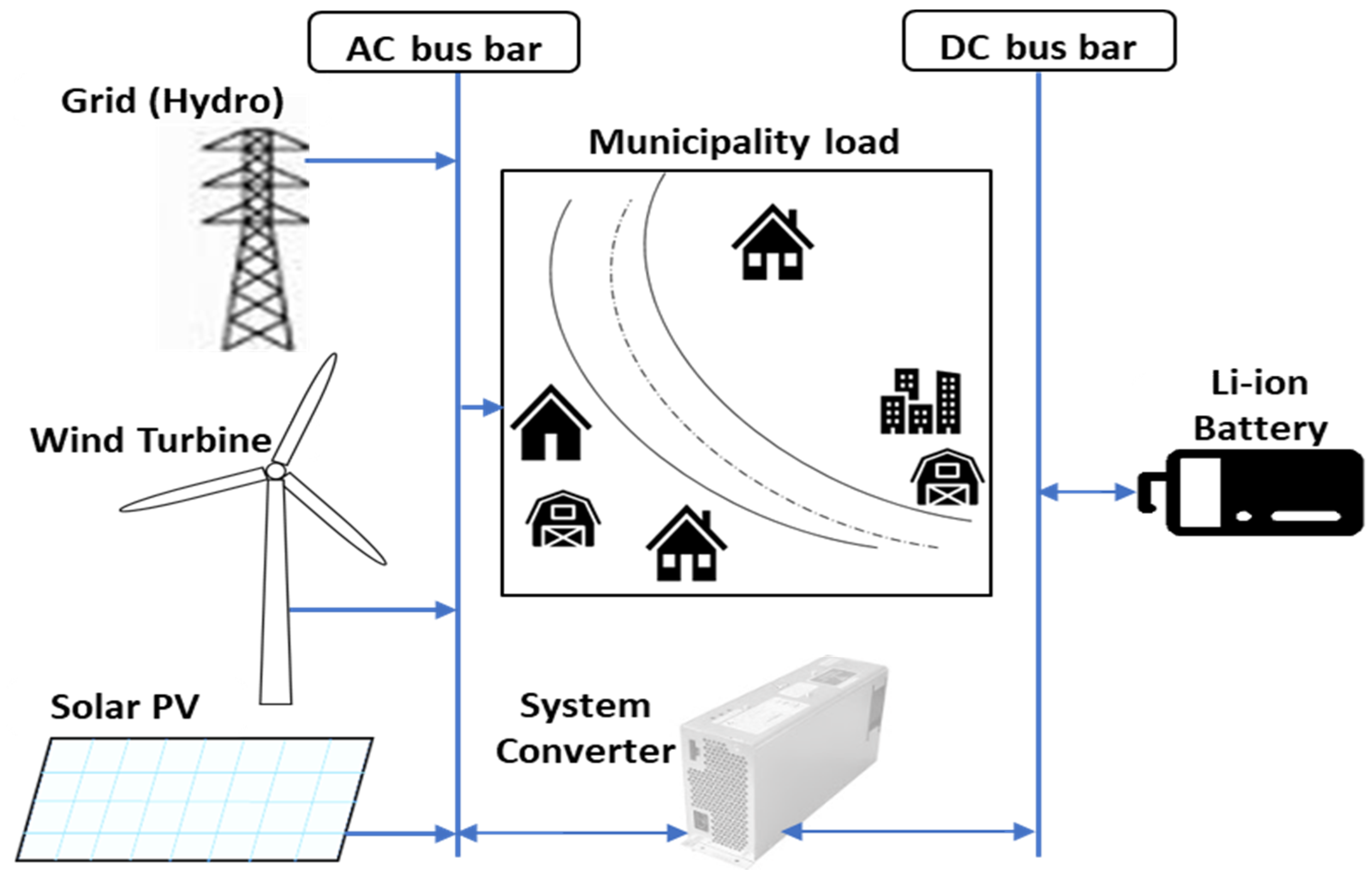
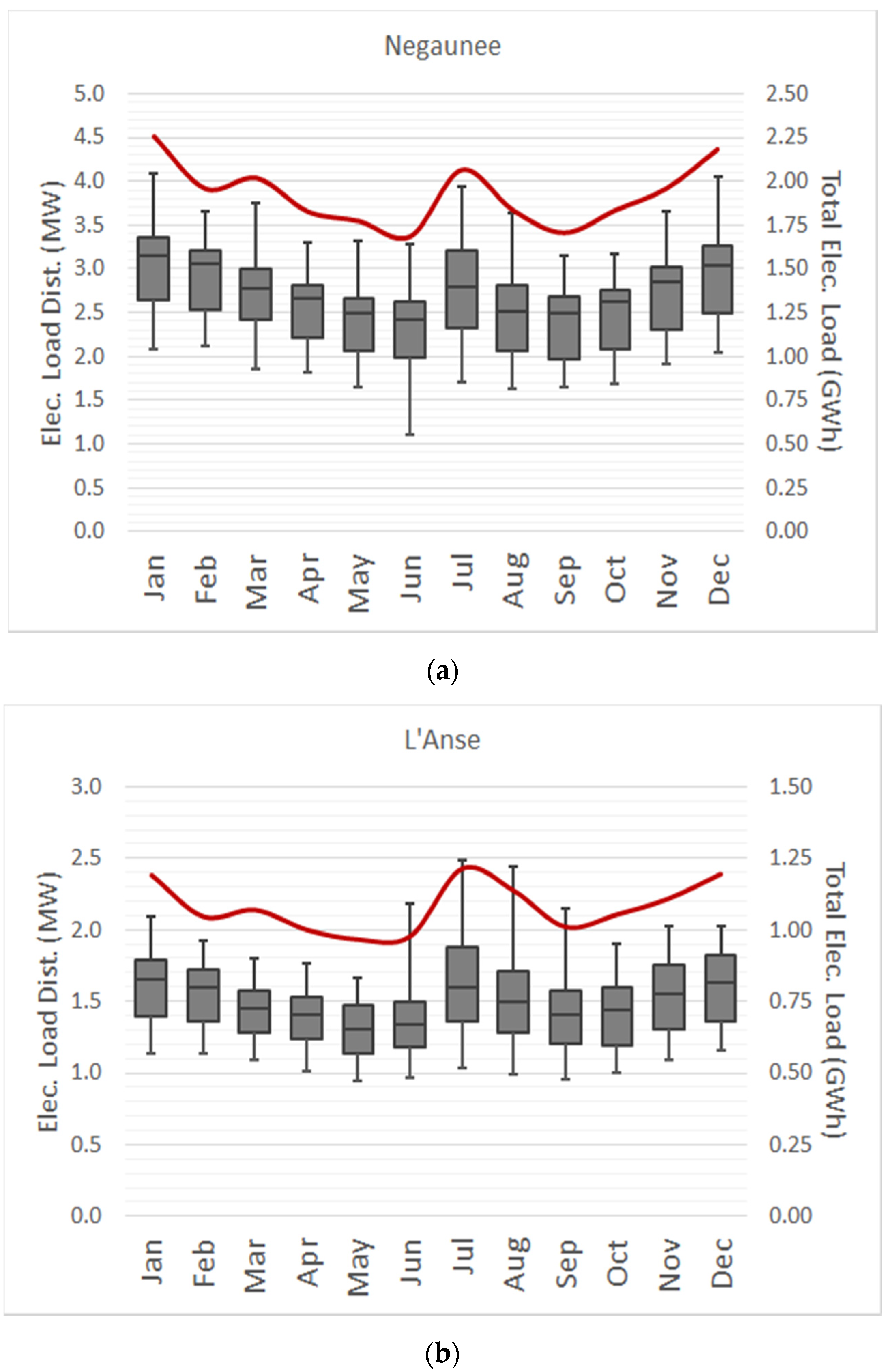


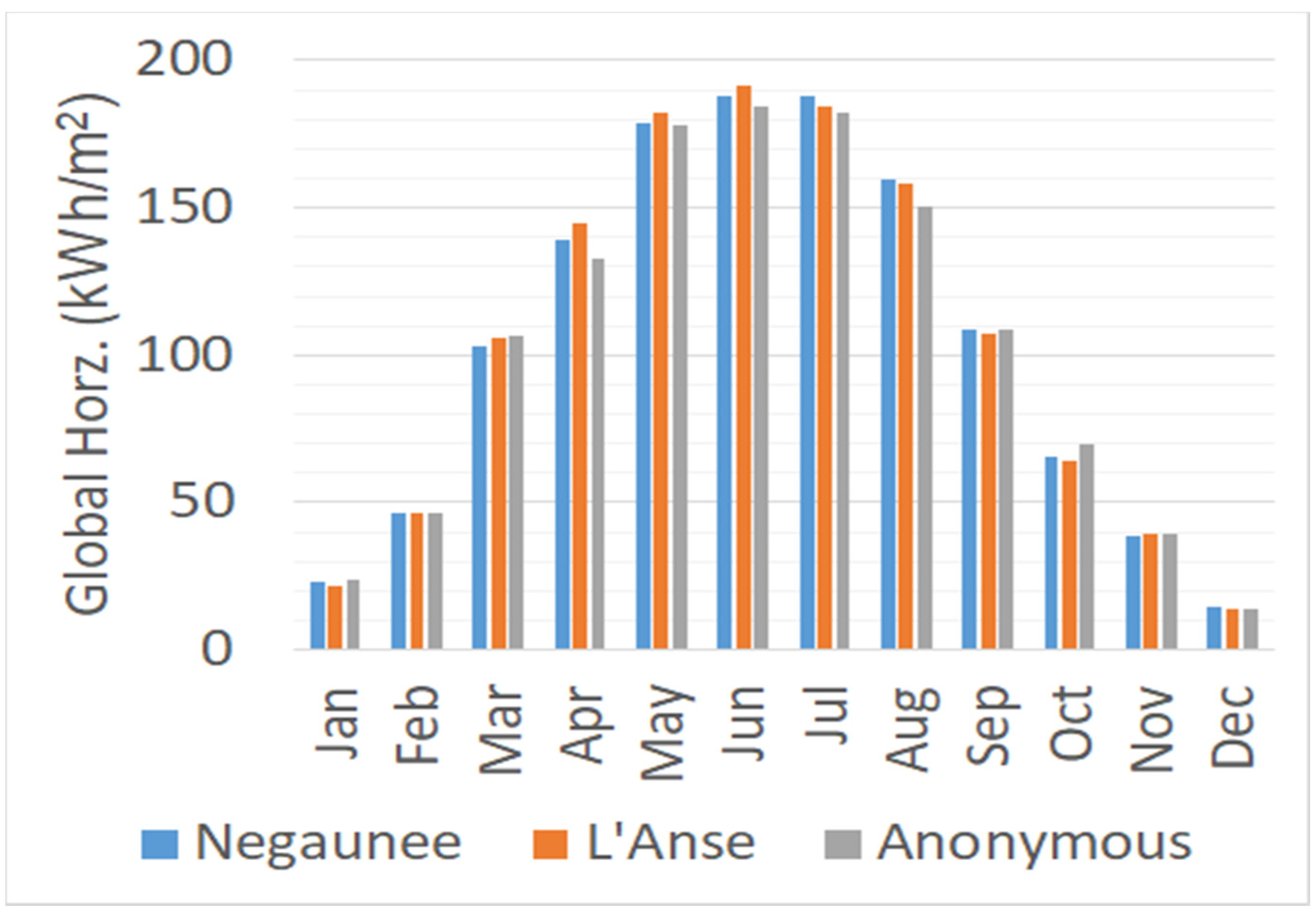
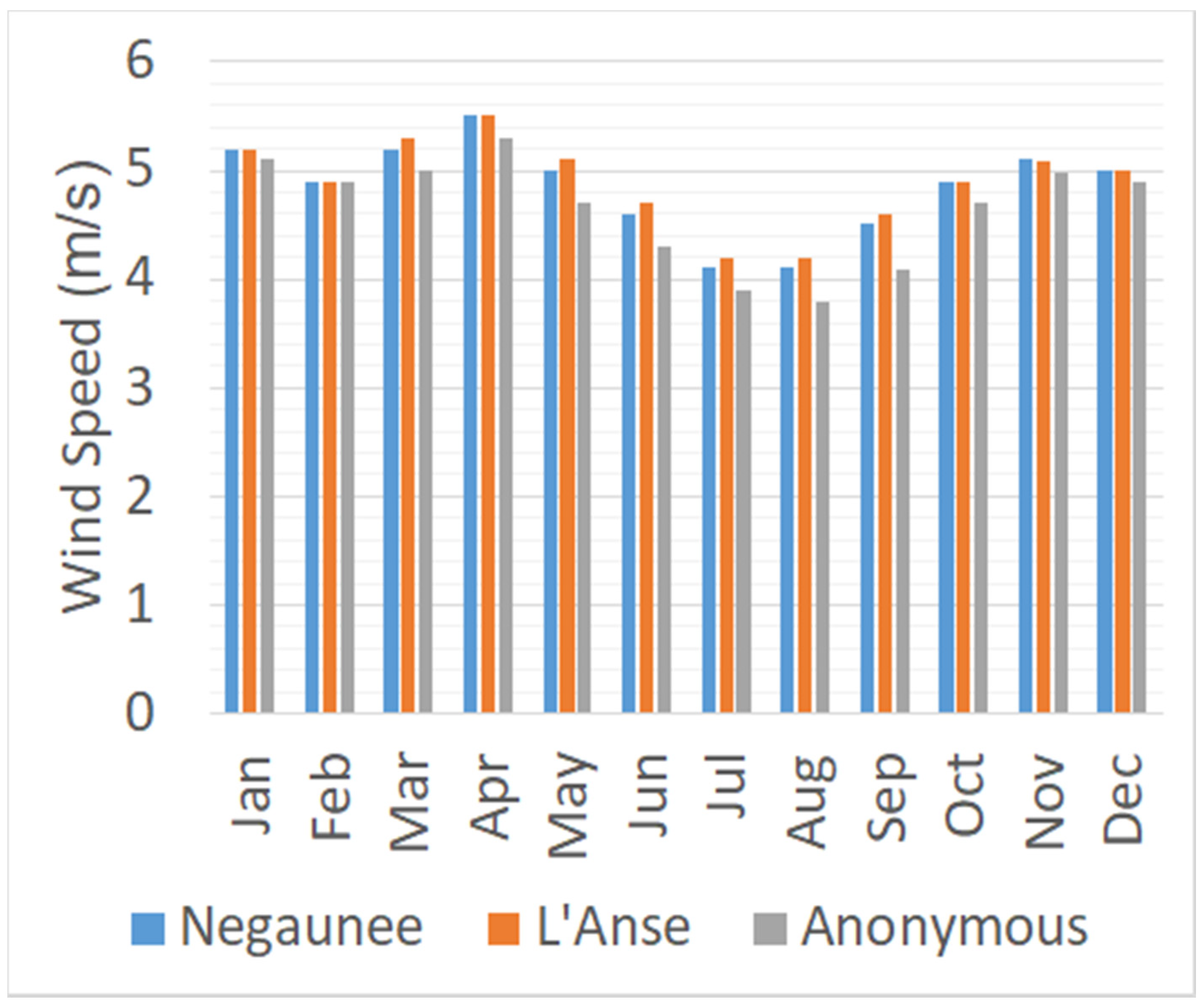

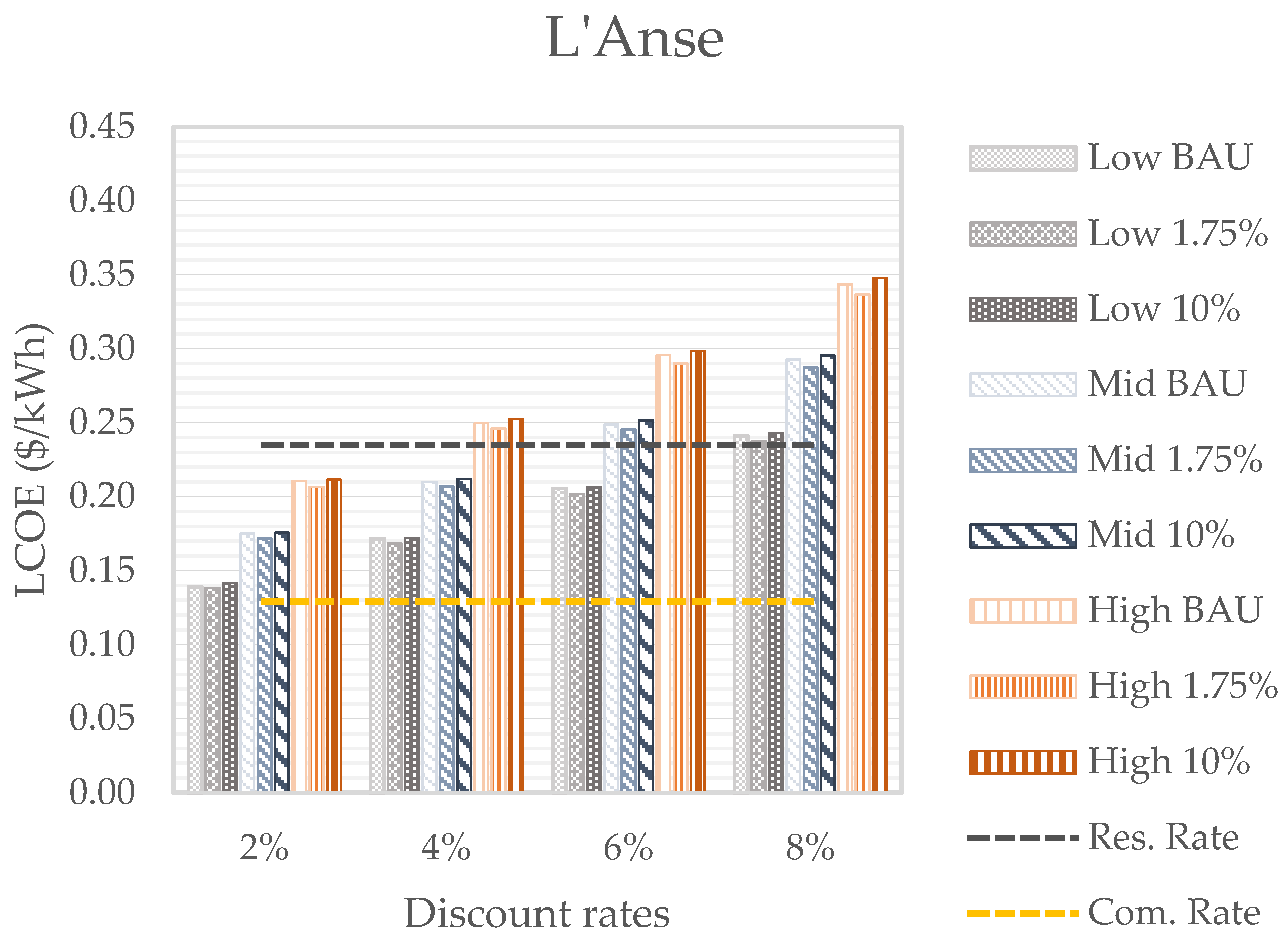

| Latitude | Longitude | Population | Average Load (MW) | Peak Load (MW) | |
|---|---|---|---|---|---|
| Negaunee | 46.4928 N | 87.6070 W | 4547 | 2.54 | 4.09 |
| L’Anse | 46.7528 N | 88.4480 W | 1872 | 1.48 | 2.49 |
| Anonymous municipality in WUP | - | - | 10,005 | 9.72 | 16.3 |
| Solar PV Tilt Angle | 30° | 45° | 60° | |
|---|---|---|---|---|
| L’Anse | Seasonal | 21.0% | 11.7% | 5.1% |
| Annual | 10.0% | 5.6% | 2.4% | |
| Negaunee | Seasonal | 21.5% | 12.0% | 5.7% |
| Annual | 10.1% | 5.7% | 2.7% | |
| Anonymous | Seasonal | 22.1% | 11.6% | 5.9% |
| Annual | 10.6% | 5.6% | 2.8% | |
| Estimate | High | Mid | Low |
|---|---|---|---|
| Capital | 359 | 330 | 297 |
| Replacement | 291 | 194 | 112 |
| Peak Capacity (kW) | Allocation (GWh/yr) | Minimum RF | |
|---|---|---|---|
| Negaunee | 1432 | 5.646 | 75.6% |
| L’Anse | 590 | 2.325 | 82.1% |
| Anonymous | 3150 | 12.417 | 85.4% |
| Components | Low | High | Increment | Lifetime |
|---|---|---|---|---|
| PV + inverter capital cost ($/kWac) | 1200 | 2000 | 200 | 30 |
| Wind turbine capital cost ($/kWac) | 900 | 1500 | 100 | 30 |
| Load reduction via energy efficiency (%) | 1.75 | 10 | n/a (assumed aggressive EE) | - |
| PV tilt angle (degrees) | 30 | 60 | 15 | - |
| Real discount rate (%) | 2 | 8 | 2 | - |
| L’Anse | Low | Mid | High | |||||||
| PV (MW) | Wind (MW) | Batt (MWh) | PV (MW) | Wind (MW) | Batt (MWh) | PV (MW) | Wind (MW) | Batt (MWh) | ||
| Capacity | 1.7 | 8 | 70 | 2 | 8 | 70 | 2.2 | 8 | 69 | |
| LCOE ($/kWh) | 0.1582 | 0.1813 | 0.2049 | |||||||
| Capital (M$) | 34.2 | 37.5 | 39.6 | |||||||
| Excess (%) | 49.5 | 50 | 50.5 | |||||||
| Negaunee | Low | Mid | High | |||||||
| PV (MW) | Wind (MW) | Batt (MWh) | PV (MW) | Wind (MW) | Batt (MWh) | PV (MW) | Wind (MW) | Batt (MWh) | ||
| Capacity | 4.8 | 10 | 94 | 5 | 10 | 93 | 6 | 10 | 89 | |
| LCOE ($/kWh) | 0.1348 | 0.1516 | 0.1673 | |||||||
| Capital (M$) | 50.2 | 53.4 | 56.3 | |||||||
| Excess (%) | 38.5 | 38.9 | 40.4 | |||||||
| Anonymous | Low | Mid | High | |||||||
| PV (MW) | Wind (MW) | Batt (MWh) | PV (MW) | Wind (MW) | Batt (MWh) | PV (MW) | Wind (MW) | Batt (MWh) | ||
| Capacity | 34.9 | 38 | 528 | 33 | 44 | 510 | 26.8 | 76 | 439 | |
| LCOE ($/kWh) | 0.1879 | 0.2096 | 0.2195 | |||||||
| Capital (M$) | 271 | 287 | 308 | |||||||
| Excess (%) | 41.3 | 45.8 | 62.3 | |||||||
| L’Anse | 30° Tilt | 45° Tilt | 60° Tilt | |||||||
| PV (MW) | Wind (MW) | Batt (MWh) | PV (MW) | Wind (MW) | Batt (MWh) | PV (MW) | Wind (MW) | Batt (MWh) | ||
| Capacity | 0.86 | 10 | 68.7 | 1.98 | 8 | 70.1 | 0 | 12 | 71.2 | |
| LCOE ($/kWh) | 0.177 | 0.1813 | 0.1808 | |||||||
| Capital (M$) | 37.7 | 37.5 | 39.7 | |||||||
| Excess (%) | 56.5 | 50 | 62 | |||||||
| Negaunee | 30° Tilt | 45° Tilt | 60° Tilt | |||||||
| PV (MW) | Wind (MW) | Batt (MWh) | PV (MW) | Wind (MW) | Batt (MWh) | PV (MW) | Wind (MW) | Batt (MWh) | ||
| Capacity | 3.38 | 12 | 108.5 | 5.95 | 10 | 93.5 | 7.77 | 10 | 79.3 | |
| LCOE ($/kWh) | 0.1649 | 0.1516 | 0.143 | |||||||
| Capital (M$) | 58.1 | 53.4 | 52.5 | |||||||
| Excess (%) | 43.5 | 38.9 | 41.9 | |||||||
| Anonymous | 30° Tilt | 45° Tilt | 60° Tilt | |||||||
| PV (MW) | Wind (MW) | Batt (MWh) | PV (MW) | Wind (MW) | Batt (MWh) | PV (MW) | Wind (MW) | Batt (MWh) | ||
| Capacity | 26.6 | 52 | 539.4 | 33 | 44 | 510.4 | 43.8 | 32 | 416.2 | |
| LCOE ($/kWh) | 0.2166 | 0.2096 | 0.1878 | |||||||
| Capital (M$) | 296.1 | 287.1 | 259.3 | |||||||
| Excess (%) | 48.8 | 45.8 | 39.4 | |||||||
Publisher’s Note: MDPI stays neutral with regard to jurisdictional claims in published maps and institutional affiliations. |
© 2022 by the authors. Licensee MDPI, Basel, Switzerland. This article is an open access article distributed under the terms and conditions of the Creative Commons Attribution (CC BY) license (https://creativecommons.org/licenses/by/4.0/).
Share and Cite
Adesanya, A.A.; Sommerfeldt, N.; Pearce, J.M. Achieving 100% Renewable and Self-Sufficient Electricity in Impoverished, Rural, Northern Climates: Case Studies from Upper Michigan, USA. Electricity 2022, 3, 264-296. https://doi.org/10.3390/electricity3030016
Adesanya AA, Sommerfeldt N, Pearce JM. Achieving 100% Renewable and Self-Sufficient Electricity in Impoverished, Rural, Northern Climates: Case Studies from Upper Michigan, USA. Electricity. 2022; 3(3):264-296. https://doi.org/10.3390/electricity3030016
Chicago/Turabian StyleAdesanya, Adewale A., Nelson Sommerfeldt, and Joshua M. Pearce. 2022. "Achieving 100% Renewable and Self-Sufficient Electricity in Impoverished, Rural, Northern Climates: Case Studies from Upper Michigan, USA" Electricity 3, no. 3: 264-296. https://doi.org/10.3390/electricity3030016
APA StyleAdesanya, A. A., Sommerfeldt, N., & Pearce, J. M. (2022). Achieving 100% Renewable and Self-Sufficient Electricity in Impoverished, Rural, Northern Climates: Case Studies from Upper Michigan, USA. Electricity, 3(3), 264-296. https://doi.org/10.3390/electricity3030016








